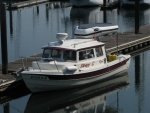Yes Colby, the Mustang jacket & bibs will protect from rain & slow the water down from reaching the body if dunked, but definitely will not stop it. Basically good for a quick dunk & flotation, while getting yourself out of the cold water along with very comfortable to wear when it’s in the 40’s & 50’s or colder & cloudy, foggy or rainy weather. Better then fleece & other rain gear if dunked, but no way comparable to a dry suit. In my passed explorations on the Mokai a dry suit in some places would have been a better choice except for ease of use. I got the Mustang tops & bottoms for Jo-Lee & I, when we were doing cold water lakes & rivers in our RIB before the C-Dory & didn’t think the risk after going to the C-Dory & Mokai big enough to justify the costly dry suits. I personally don’t think a dry suit for what Jo-Lee & I do now worth the cost & doubt if it would be worth it to you either, but only you can determine that. At this point if I didn’t have the Mustang combos, I would feel comfortable using just rain gear with fleece type material layered under & like Bob said, 18 inch boots. On our last Alaska trip, I used only the 18 inch Chota, though we had the hip boots aboard. To save space we’re considering leaving them behind next trip. When exploring with the Mokai, the swift rivers with lots of down trees in them, I would only use the Chota boots as the hip waters or waist high would have been way to dangerous to use for the reasons others have addressed. For the same reason, we did not use hip waders in the past when exploring larger lakes & rivers on the RIB & haven’t on the ocean recently, except when just going to shore or exploring the heads of smaller protected bays.
The main reason, I waited so long to post on this thread is my lack of experience with regular kayaks leaving me not knowing how stable your Hobie or Sea Eagle are. Your use & their stability may justify the cost of a dry suit or at least a top as others have suggested. You should & no doubt do realize all who are responding on this thread, have different levels of risk assessment, that will determine what they think justifies the cost of the equipment, thought necessary for your proposed use.
Jay

